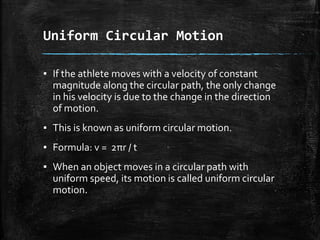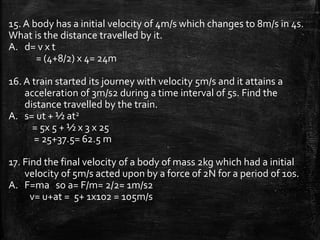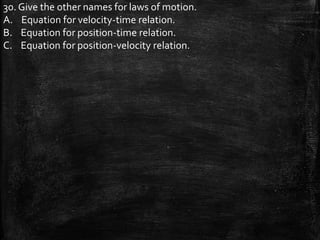Motion 2
- 1. Motion 2
- 2. Velocity time graphs ▪ The variation in velocity with time for an object moving in a straight line can be represented by a velocity-time graph. ▪ Time is represented along the x-axis and the velocity is represented along the y-axis.
- 3. Uniform motion velocity time graph If the object moves at uniform velocity, the height of its velocity- time graph will not change with time. It will be a straight line parallel to the x-axis. Distance in time t2-t1 =area of the rectangle ABDC
- 4. Uniform acceleration velocity time graph The nature of the graph shows that velocity changes by equal amounts in equal intervals of time. Thus, for all uniformly accelerated motion, the velocity-time graph is a straight line.
- 5. Non-Uniform acceleration velocity time graph (a) shows a velocity-time graph that represents the motion of an object whose velocity is decreasing with time. (b) shows the velocity-time graph representing the non- uniform variation of velocity of the object with time.
- 6. Equations of Motion Graphical method ▪ v = u + at ▪ s = ut + ½ at2 ▪ 2 a s = v2 – u2 ▪ These are the three laws of motion. ▪ u is the initial velocity of the object which moves with uniform acceleration a for time t, v is the final velocity, and s is the distance travelled by the object in time t.
- 7. Equation for velocity-time relation
- 8. Equation for position-time relation ▪ From the same diagram above
- 9. Equation for position–velocity relation ▪ From the same diagram
- 10. Uniform Circular Motion ▪ If the athlete moves with a velocity of constant magnitude along the circular path, the only change in his velocity is due to the change in the direction of motion. ▪ This is known as uniform circular motion. ▪ Formula: v = 2πr / t ▪ When an object moves in a circular path with uniform speed, its motion is called uniform circular motion.
- 11. Examples of uniform circular motion ▪ Motion of the moon and the earth. ▪ A satellite in a circular orbit around the earth. ▪ A cyclist on a circular track at constant speed.
- 12. 1. What is a velocity time graph? A.The variation in velocity with time for an object moving in a straight line can be represented by a velocity-time graph. 2. Find the distance from the graph A. A. Distance= area of the diagram =base x height = 15x4= 60 m
- 13. 3. From the given table plot a graph and analyze whether it is uniformly accelerated or not. A. From the graph it is a straight Line so it is a uniformly Accelerated motion. 4. Calculate the distance of the above situation from 10s to 15s. A. Area= 5x4 + ½ (5x2) = 20+ 5= 25m Time (s) Velocity(m/s) 5 2 10 4 15 6
- 14. 5. How does a graph appear in case of a non-uniformly accelerated motion. A. In the case of non-uniformly accelerated motion, velocity-time graphs can have any shape. 6.What can you say about the velocity of a body if the graph is a parallel line to the x-axis. A. When the line is parallel to x-axis in a velocity time graph it shows that the velocity is constant. 7. Show some examples of a non-uniformly accelerated motion. A.
- 15. 8. Comment on the graph and interpret if its uniformly accelerated. A. It is a straight line so it is uniformly accelerated. 9.What is the area in the distance time different from the area in velocity time graph. A. Area in distance time graph gives the velocity and the area in a velocity time graph gives the displacement. 10.When a car is in uniform motion does it also have uniform acceleration. A.Yes, this is because when it is uniform the change in velocity is 0 and so there is uniform acceleration.
- 16. 11. Give the derivation of the second law of motion. A. Diagram slide 7 12. Give the derivation of first law of motion. A. Diagram refer slide 7
- 17. 13. Give the derivation of third law of motion. A. 14.What are the three laws of motion. A. v = u + at s = ut + ½ at2 2 a s = v2 – u2
- 18. 15. A body has a initial velocity of 4m/s which changes to 8m/s in 4s. What is the distance travelled by it. A. d= v x t = (4+8/2) x 4= 24m 16. A train started its journey with velocity 5m/s and it attains a acceleration of 3m/s2 during a time interval of 5s. Find the distance travelled by the train. A. s= ut + ½ at2 = 5x 5 + ½ x 3 x 25 = 25+37.5= 62.5 m 17. Find the final velocity of a body of mass 2kg which had a initial velocity of 5m/s acted upon by a force of 2N for a period of 10s. A. F=ma so a= F/m= 2/2= 1m/s2 v= u+at = 5+ 1x102 = 105m/s
- 19. 18. Find the time taken by a body to change its velocity from 5m/s to a value which will yield a acceleration of 2m/s2 with a final velocity of 10m/s. A. T = v-u/a = 10-5/2= 2.5s 19.The brakes applied to a car produce an acceleration of 5 m s-2 in the opposite direction to the motion. If the car takes 3 s to stop after the application of brakes, calculate the distance it travels during this time. A. v = u + at = u-5x3 = 0 So u=15m/s S = ut + ½ at2 = 15x3+ (5x9)/2 = 45-22.5 =22.5m 20.What is negative acceleration? Deceleration.
- 20. 21.What could be the possible reasons for change in velocity? A. The change in the velocity could be due to change in its magnitude or the direction of the motion or both. 22.What is uniform circular motion? A. When an object moves in a circular path with uniform speed, its motion is called uniform circular motion. 23. How will you calculate the velocity in a uniform circular motion. A. v= circumference/time= 2πr / t 24. Give examples of uniform circular motion A. Motion of the moon and the earth. A satellite in a circular orbit around the earth. A cyclist on a circular track at constant speed.
- 21. 25.What will happen if you release a string with stone. A. On being released the stone moves along a straight line tangential to the circular path. 26.Why does the string move in a tangential path. A. That is because once the stone is released, it continues to move along the direction it has been moving at that instant.This shows that the direction of motion changed at every point when the stone was moving along the circular path. 27. A train starting from rest attains a velocity of 108km h–1 in 2 minutes. Assuming that the acceleration is uniform, find (i) the acceleration and (ii) the distance travelled by the train for attaining this velocity. A. v= 30m/s t= 120s, a= 30-0/120= 30/120= 0.25m/s2 s= v^2/2a= 900/ 2x0.0625 = 900/0.125= 7200 m
- 22. 28. How will you distance in this graph. A. s = area ABCDE = area of the rectangle ABCD + area of the triangle ADE = AB × BC + ½ (AD × DE) 29. In which way do the images represent Non-uniformly accelerated motion. A. Motion of an object whose velocity is decreasing with time. B. Non-uniform variation of velocity of the object with time
- 23. 30. Give the other names for laws of motion. A. Equation for velocity-time relation. B. Equation for position-time relation. C. Equation for position-velocity relation.























